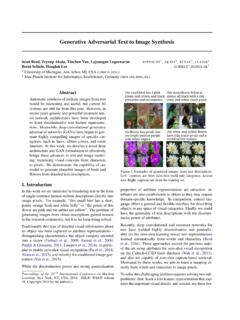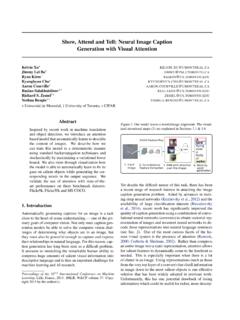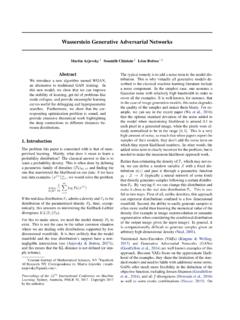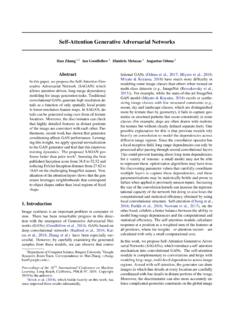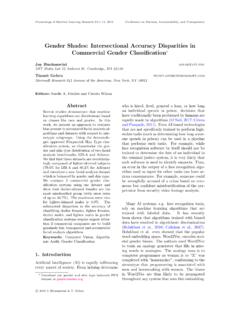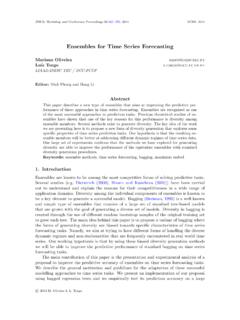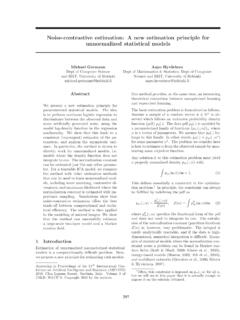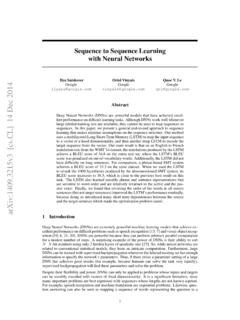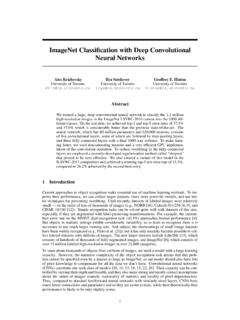Transcription of Communication-Efficient Learning of Deep Networks from ...
1 Communication-Efficient Learning of deep Networksfrom Decentralized DataH. Brendan McMahanEider MooreDaniel RamageSeth HampsonBlaise Ag uera y ArcasGoogle, Inc., 651 N 34th St., Seattle, WA 98103 USAA bstractModern mobile devices have access to a wealthof data suitable for Learning models, which in turncan greatly improve the user experience on thedevice. For example, language models can im-prove speech recognition and text entry, and im-age models can automatically select good , this rich data is often privacy sensitive,large in quantity, or both, which may precludelogging to the data center and training there usingconventional approaches. We advocate an alter-native that leaves the training data distributed onthe mobile devices, and learns a shared model byaggregating locally-computed updates. We termthis decentralized approachFederated present a practical method for the federatedlearning of deep Networks based on iterativemodel averaging, and conduct an extensive empiri-cal evaluation, considering five different model ar-chitectures and four datasets.
2 These experimentsdemonstrate the approach is robust to the unbal-anced and non-IID data distributions that are adefining characteristic of this setting. Commu-nication costs are the principal constraint, andwe show a reduction in required communicationrounds by 10 100 as compared to synchronizedstochastic gradient IntroductionIncreasingly, phones and tablets are the primary computingdevices for many people [30,2]. The powerful sensors onthese devices (including cameras, microphones, and GPS),combined with the fact they are frequently carried, meansthey have access to an unprecedented amount of data, muchof it private in nature. Models learned on such data hold theProceedings of the20thInternational Conference on Artificial In-telligence and Statistics (AISTATS) 2017, Fort Lauderdale, Florida,USA. JMLR: W&CP volume 54. Copyright 2017 by the author(s).
3 Promise of greatly improving usability by powering moreintelligent applications, but the sensitive nature of the datameans there are risks and responsibilities to storing it in acentralized investigate a Learning technique that allows users tocollectively reap the benefits of shared models trained fromthis rich data, without the need to centrally store it. We termour approachFederated Learning , since the Learning task issolved by a loose federation of participating devices (whichwe refer to asclients) which are coordinated by a centralserver. Each client has a local training dataset which isnever uploaded to the server. Instead, each client computesan update to the current global model maintained by theserver, and only this update is communicated. This is adirect application of the principle offocused collectionordata minimizationproposed by the 2012 White House reporton privacy of consumer data [39].
4 Since these updates arespecific to improving the current model, there is no reasonto store them once they have been principal advantage of this approach is the decoupling ofmodel training from the need for direct access to the rawtraining data. Clearly, some trust of the server coordinat-ing the training is still required. However, for applicationswhere the training objective can be specified on the basisof data available on each client, federated Learning can sig-nificantly reduce privacy and security risks by limiting theattack surface to only the device, rather than the device andthe primary contributions are 1) the identification of theproblem of training on decentralized data from mobile de-vices as an important research direction; 2) the selection ofa straightforward and practical algorithm that can be appliedto this setting; and 3) an extensive empirical evaluation ofthe proposed approach.
5 More concretely, we introduce theFederatedAveragingalgorithm, which combines lo-cal stochastic gradient descent (SGD) on each client witha server that performs model averaging. We perform ex-tensive experiments on this algorithm, demonstrating it isrobust to unbalanced and non-IID data distributions, andcan reduce the rounds of communication needed to train adeep network on decentralized data by orders of Learning of deep Networks from Decentralized DataFederated LearningIdeal problems for federated learn-ing have the following properties: 1) Training on real-worlddata from mobile devices provides a distinct advantage overtraining on proxy data that is generally available in the datacenter. 2) This data is privacy sensitive or large in size (com-pared to the size of the model), so it is preferable not to logit to the data center purely for the purpose of model training(in service of thefocused collectionprinciple).
6 3) For super-vised tasks, labels on the data can be inferred naturally fromuser models that power intelligent behavior on mobiledevices fit the above criteria. As two examples, we con-siderimage classification, for example predicting whichphotos are most likely to be viewed multiple times in thefuture, or shared; andlanguage models, which can be usedto improve voice recognition and text entry on touch-screenkeyboards by improving decoding, next-word-prediction,and even predicting whole replies [10]. The potential train-ing data for both these tasks (all the photos a user takes andeverything they type on their mobile keyboard, includingpasswords, URLs, messages, etc.) can be privacy distributions from which these examples are drawn arealso likely to differ substantially from easily available proxydatasets: the use of language in chat and text messages isgenerally much different than standard language corpora, , Wikipedia and other web documents; the photos peopletake on their phone are likely quite different than typicalFlickr photos.
7 And finally, the labels for these problems aredirectly available: entered text is self-labeled for learninga language model, and photo labels can be defined by natu-ral user interaction with their photo app (which photos aredeleted, shared, or viewed).Both of these tasks are well-suited to Learning a neural net-work. For image classification feed-forward deep Networks ,and in particular convolutional Networks , are well-knownto provide state-of-the-art results [26,25]. For languagemodeling tasks recurrent neural Networks , and in particularLSTMs, have achieved state-of-the-art results [20, 5, 22].PrivacyFederated Learning has distinct privacy advan-tages compared to data center training on persisted even an anonymized dataset can still put userprivacy at risk via joins with other data [37]. In contrast,the information transmitted for federated Learning is theminimal update necessary to improve a particular model(naturally, the strength of the privacy benefit depends on thecontent of the updates).
8 1 The updates themselves can (andshould) be ephemeral. They will never contain more infor-1 For example, if the update is the total gradient of the loss onall of the local data, and the features are a sparse bag-of-words,then the non-zero gradients reveal exactly which words the userhas entered on the device. In contrast, the sum of many gradientsfor a dense model such as a CNN offers a harder target for attackersseeking information about individual training instances (thoughattacks are still possible).mation than the raw training data (by the data processinginequality), and will generally contain much less. Further,the source of the updates is not needed by the aggregationalgorithm, so updates can be transmitted without identifyingmeta-data over a mix network such as Tor [7] or via a trustedthird party. We briefly discuss the possibility of combiningfederated Learning with secure multiparty computation anddifferential privacy at the end of the OptimizationWe refer to the optimizationproblem implicit in federated Learning as federated optimiza-tion, drawing a connection (and contrast) to distributed opti-mization.
9 Federated optimization has several key propertiesthat differentiate it from a typical distributed optimizationproblem: Non-IIDThe training data on a given client is typicallybased on the usage of the mobile device by a particularuser, and hence any particular user s local dataset willnot be representative of the population distribution. UnbalancedSimilarly, some users will make muchheavier use of the service or app than others, leadingto varying amounts of local training data. Massively distributedWe expect the number ofclients participating in an optimization to be muchlarger than the average number of examples per client. Limited communicationMobile devices are fre-quently offline or on slow or expensive this work, our emphasis is on the non-IID and unbalancedproperties of the optimization, as well as the critical natureof the communication constraints.
10 A deployed federatedoptimization system must also address a myriad of practicalissues: client datasets that change as data is added anddeleted; client availability that correlates with the local datadistribution in complex ways ( , phones from speakersof American English will likely be plugged in at differenttimes than speakers of British English); and clients thatnever respond or send corrupted issues are beyond the scope of the current work;instead, we use a controlled environment that is suitablefor experiments, but still addresses the key issues of clientavailability and unbalanced and non-IID data. We assumea synchronous update scheme that proceeds in rounds ofcommunication. There is a fixed set ofKclients, eachwith a fixed local dataset. At the beginning of each round,a random fractionCof clients is selected, and the serversends the current global algorithm state to each of theseclients ( , the current model parameters).

